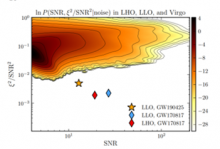
Abstract
On 2019 April 25, the LIGO Livingston detector observed a compact binary coalescence with signal-to-noise ratio 12.9. The Virgo detector was also taking data that did not contribute to detection due to a low signal-to-noise ratio, but were used for subsequent parameter estimation. The 90% credible intervals for the component masses range from 1.12 to 2.52 M⊙ (1.45 to 1.88 M⊙ if we restrict the dimensionless component spin magnitudes to be smaller than 0.05). These mass parameters are consistent with the individual binary components being neutron stars. However, both the source-frame chirp mass 1.44+0.02−0.02M⊙ and the total mass 3.4+0.3−0.1M⊙ of this system are significantly larger than those of any other known binary neutron star system. The possibility that one or both binary components of the system are black holes cannot be ruled out from gravitational-wave data. We discuss possible origins of the system based on its inconsistency with the known Galactic binary neutron star population. Under the assumption that the signal was produced by a binary neutron star coalescence, the local rate of neutron star mergers is updated to 250−2810Gpc−3yr−1.